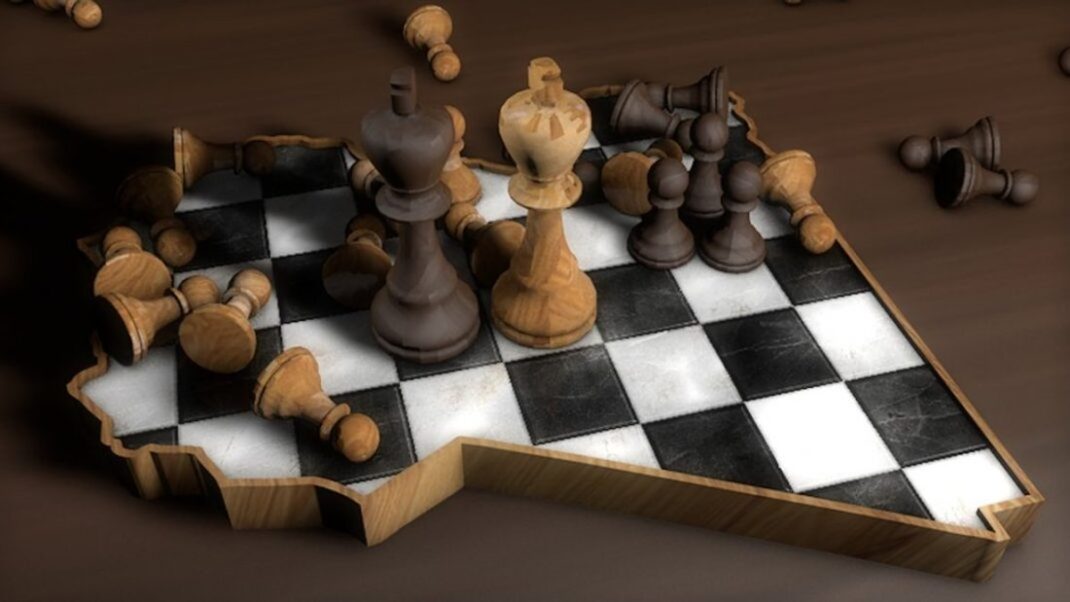By Mohamed Eljarh & Mohamed Dorda


This paper explores the divergence and convergence between Europe and Russia in Libya.
.
PART (I)
Over the past ten years, Libya has increasingly become a target for Russia’s growing ambitions to influence the Middle East, North Africa and the wider Mediterranean region.
In 2016, when Russia started increasing its involvement in Libya, the Kremlin’s actions suggested that Moscow was either hedging its bets between competing political actors in Libya or that it had not yet settled on clear policy objectives.
However, this changed in September 2019, when Wagner Group private military contractors (PMCs) affiliated with the Kremlin took on an active combat role on the frontlines in Tripoli — fighting in favour of Haftar, the Libyan National Army (LNA) against the UN-recognised Government of National Accord (GNA).
Today, Russia is increasing its military and diplomatic footprint in Libya in an attempt to position itself as a strategic partner for authorities in eastern Libya, mainly the President of the House of Representatives (HoR) Agilah Saleh and the General Commander of the Libyan National Army Khalifa Haftar.
In his 2016 article for Russia in Global Affairs titled “Russia’s Foreign Policy in a Historical Perspective”, Russian Foreign Minister Sergey Lavrov asserts that following the rule of Peter the Great, “Russia could no longer be ignored, and no serious European issue could be solved without it”.
In the same year, French President Emmanuel Macron remarked that Russia was an essential partner for Europe’s security and argued that the European Union (EU) should create a security architecture that included Russia.
Today, Russia’s growing involvement in Libya has become a pressing concern for the United States and some of its allies in NATO. Equally, Turkey’s growing influence in western Libya has put the EU in a precarious position.
While the United States and the United Kingdom have taken a hard-line position on Russia’s involvement in Libya, many EU countries — France in particular — are adopting a softer and conciliatory position.
By contrast, the policy perspectives of the same countries with respect to Turkey seem to be reversed, evidencing a greater dichotomy occurring within NATO.
All the while, particularly in recent months, Turkey and Russia have demonstrated their ability to aptly manage their current rivalry without affecting their long-term strategic partnership.
Against this backdrop, Europe continues to struggle to find its place in the MENA region in general and Libya in particular. To be sure, only a unified European position could impact the nature of Russia’s role in Libya.
In this regard, Europe will need to adopt a sharp and realistic strategy towards Libya that goes beyond the boundaries set by the Libyan Political Agreement (LPA) signed in 2015, the so-called “Skhirat Agreement.”
The latter is the fundamental difference between the European and the Russian policy approaches to Libya (Russia choosing to engage with all Libyan actors).
Additionally, Europe will also need to choose between cooperation on issues such as reconstruction and development of Libya’s energy sector, migration and counter-terrorism or opt for open opposition to Putin’s moves in Libya.
This paper explores the divergence and convergence between Europe and Russia in Libya. The argument that follows will focus on Russia’s interests in the Mediterranean Sea in light of the Turkey-GNA maritime agreement; the instrumentalization of the Libyan case in Russia; Russia’s relations with Europe and Turkey, and whether the case of Libya represents an opportunity for rapprochement between Russia and Europe.
The Backdrop to Russia’s Operations in The Mediterranean
Over the past decade, Russia’s return to Arab affairs has raised speculation around the virtual enactment of Peter the Great’s dream to access the warm waters of the Mediterranean.
Russia’s regained influence in the region (a policy that the former Soviet Union had already followed) is all the more impressive in that the Kremlin has put security concerns at the heart of bilateral ties whilst managing to sustain relations across the region’s ideological spectrum.
This means that Russian President Vladimir Putin is as welcome in Ankara as he is in Riyadh, and that his close military collaboration with Iran in Syria has not weakened his strong ties with Egypt or the United Arab Emirates (UAE).
This impressive feat can be partly explained by the feeling of gradual abandonment felt by the Arab world towards the United States and Europe, and the growing need to find a counterbalancing force in the region.
Nevertheless, the truth remains that Russia exercised considerable diplomatic efforts to perturb and even replace Western influence in the region. These gains have been achieved with far less resources but a decisively more pragmatic foreign policy that revolves around military cooperation, armament and narrow investments in energy or construction.
The pragmatic approach that Russia has displayed over the last decade should lead Europe to reassess its high investment—low return foreign policy approach that has thus far failed to deliver tangible results. If anything, such a splintered policy position by European states has created a suitable environment for Russia to insert itself as a more suitable alternative.
A case in point is Moscow’s and Ankara’s ability to amass a level of influence in Libya that Europeans have failed to achieve throughout the last decade.
Russia and Nato’s “CYNICAL Deception” in Libya
Without a doubt, the 2011 intervention in Libya had a fundamental impact on Russian foreign policy. The direct military intervention in 2011 and the civil war that ensued had a deep imprint on the Russians and arguably led them to their early position on Syria.
Russian officials have been very clear about their reservations towards the 2011 military intervention that led to the toppling of Gaddafi, despite not arguing against the fact that Libyans needed a change from the 42-year autocracy.
During the 2018 Palermo International Conference for Libya that was organized by Italy, Dmitry Medvedev, former President of Russia at the time of the Libyan revolution, went as far as describing the NATO-led and European sponsored intervention as a “cynical deception” that distorted and violated the decisions of the United Nations Security Council (UNSC).
Facing the Post-2011 Reshuffling of Cards
The onset of the post-revolutionary era also meant that Russia had lost lucrative ties to a regime with which it had signed significant arms, energy and construction deals, valued around USD 4 billion.
To this day, most weapons used in Libya are Soviet-era armaments — mementos of the close ties that Gaddafi had entertained with Moscow at the expense of the West.
Regardless of the repeated incidents involving Russians in western Libya, the 2011 revolutionaries were quick to appeal to Moscow. Mahmoud Jibril, the leader of the National Forces Alliance, called for a “new page” in relations between the two countries in February 2013.
Russia’s decision not to veto UNSCR 1973 was received well throughout Libya and led militia commanders to believe they could receive training, modern weapons and technical cooperation from Moscow.
Interestingly, in 2012, this newfound openness towards Russia led to USD 250 million in trade turnover between the two countries — the highest turnover Russia had recorded in Libya since 2000.
Gradually, however, as the second Libyan civil war approached in 2014, the Kremlin shifted its stance from critical to Western policy towards Libya to take up a more proactive role in Libya.
The rise of Khalifa Haftar — a Gaddafi-era general — presented Russia with an opportunity for a comeback in Libya with Haftar as Moscow’s main military interlocutor.
This led Russia to see more common interests with the Tobruk-based HoR. Highlighting this growing support, Russia printed more than 10 billion Libyan Dinars from 2015 to 2018 for the Eastern-based Al Bayda Central Bank, which was facing liquidity shortages it blamed on the Central Bank of Libya (CBL) in Tripoli.
The Central Bank in Tripoli declared the Russian printed banknotes as counterfeit, but that did not prevent their circulation throughout most of the country.
As Russia started to find its way through the complexities of the Libyan conflict, Europe lacked a common and coherent Libya policy. Italy and France were locked in a diplomatic feud that would last for years to come with the two countries supporting opposing factions in Libya.
This divergence between the two European countries helped create an environment that incentivised more dangerous forms of intervention by other non-European actors.
***
Mohamed Eljarh is co-founder of Libya Outlook for Research and Consulting, and holds the position of Regional Manager for CRCM North Africa in Libya. Previously, Eljarh was a fellow with the Atlantic Council with focus on Libya and the Libya contributor for Foreign Policy Magazine. He worked as a political and security affairs consultant for the British Envoy to Libya, Jonathan Powell and worked briefly as a political consultant for the Libyan Mission to the European Union. Eljarh has published extensively on post-Qaddafi Libya and has a vast media experience commenting on Libyan Affairs in local, regional and international media outlets. His work is published and cited by leading international Think Tanks and Media outlets.
Mohamed Dorda is a senior partner and consulting director at Libya Desk, a specialist geopolitical risk consultancy that produces evidence-based analysis on the political, regulatory, social, tribal and security environments in Libya. Mohamed holds a Bachelor’s Degree from the School of Oriental & African Studies (SOAS) and has worked extensively on Libya. Prior to Libya Desk, Dorda researched instances of arbitrary detention, torture, extra-judicial killings, and due process violations committed by various armed groups across Libya.
_______________
Source: EUROPE’S OPTIONS TO ADDRESS THE CONFLICT IN LIBYA (NAVIGATING THE REGIONAL CHESSBOARD)




